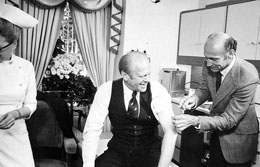The prevailing local strain of H5N1 seems to have mutated to infect a lot more people in Georgia. I bet it’s thriving in lower cell temperatures than it used to require. Noses are cooler than bellies.
The death rate hasn’t climbed much, even with influenza spreading like Sherman’s fire. Every hospital is out of ventilators. Atlanta has shut down. Water supplies from Lake Lanier have been fouled by some kind of chlorination glitch. They didn’t have much water to start with: Georgians have long been praying for rain.
But Atlanta’s so far away. In New York, we’re wearing ‘I caught H5N1 and all I got was hot!’ t-shirts. We’re attending so-called fever parties, where I doubt the powder is medical. And we’re dancing in every bar (which is actually illegal here—check out our bizarre cabaret laws).
 PRESIDENT GERALD FORD ROLLED UP HIS SLEEVE IN 1976 FOR A PANDEMIC THAT NEVER HAPPENED Baseball says it’s coming back, but I’m certain H5N1 will win the playoffs. The season had begun well for this Yankees-hating, Mets-loving, Cardinals-worshipping fan. I’ll wait till next year and hope my teams survive.
PRESIDENT GERALD FORD ROLLED UP HIS SLEEVE IN 1976 FOR A PANDEMIC THAT NEVER HAPPENED Baseball says it’s coming back, but I’m certain H5N1 will win the playoffs. The season had begun well for this Yankees-hating, Mets-loving, Cardinals-worshipping fan. I’ll wait till next year and hope my teams survive.
I still wear gear when I go out. Who wants to be the last soldier killed before a truce is declared? At least 60,000 Americans have succumbed, though it’s always difficult to quantify flu fatalities. History says the second wave may be far more intense.
Who cares? Everyone expects a vaccine by then.
The U.S. Food & Drug Administration says we might see a shot by late July. Others think September far likelier. After what happened with swine flu, you'd think the Feds wouldn't want to promise more than they and the pharmaceutical industry can deliver.
Unless Americans add adjuvants—which heighten a single dose’s effects by supercharging our immune systems—the developed world’s pandemic vaccine capacity will fall way short because two shots are probably needed. Rumors circulate that the FDA has quietly approved a batch of experimental processes and additives that haven’t been fully tested for efficacy and adverse effects. Among the controversial adjuvants is squalene, an oil accused of triggering autoimmune disorders in test animals. While it has never been approved for use in the U.S., European governments embraced adjuvants, particularly squalene, during the swine flu pandemic. Mike Coston makes the case for adjuvants here.
I’m not certain I want to be vaccinated, even for pandemic H5N1. This article sums up my problems with seasonal flu shots. I’m not so impressed by a supportive study claiming that the swine flu vaccination worked in 72% of adults under 65; it had a lot of holes and that’s not even three-quarters of the poorly collected subjects.
The Cochrane Collaboration, a respected global network of health-care personnel and institutions, has published devastating assessments regarding the usefulness of flu vaccines. A review in 2010 found that even when flu shot components perfectly match the circulating strains—a rare triumph—“vaccination had a modest effect on time off work and had no effect on hospital admissions or complication rates.”
I do not in general oppose the concept of vaccination against disease, though I think we’ve gone overboard. Even in this year of mortal threat, I’m not convinced I want to mess with my immune system. I’ve gotten this far in life and hope my personal protective gear sees me further. I feel blue enough these days without changing color.
The 1976 Swine Flu Vaccine Meltdown
The vaccine business is kind of shaky. Nineteen of 20 U.S.-based vaccine manufacturers quit the business after the swine flu debacle of 1976. A national inoculation program (watch some of its strange and colorful public service announcements) broke down after a higher-than-expected number of recipients came down with Guillain-Barré Syndrome. When that pandemic failed to materialize, American flu vaccine production collapsed. It took massive subsidies to restart it.
Which leads to something that bugs me. In a typical year, elderly subjects are herded by the busload to get seasonal flu vaccines. But in 2009, when swine flu vaccine seemed in short supply, the authorities shoved the old folks out of the line. Sure, young people were hit unusually hard by that flu, and some of the old-timers showed immunity to Novel H1N1 (possibly from so many prior exposures to influenza), but most of them evidently did not. Without much fuss, it was conceded that the elderly don’t respond all that well to flu shots. You know, those tired immune systems....
The problem is that if no one gets annual shots, pharmaceutical companies will stop making the stuff. So once the pandemic receded, the authorities revived the ‘get-out-the-old-folks’ routine. Even my stepmom grew suspicious—and she loves doctors.
Still, I reserve the right to change my mind and stick my arm out for a properly tested H5N1 shot. That’s asking a lot. Washington is teeming with lobbyists seeking emergency federal support for any products and processes their corporate clients conceive. Congress long ago immunized vaccine manufacturers from most lawsuits that might result from nasty reactions to their formulae. The men of the Supreme Court unanimously approved in 2011. (Of three female Justices, two opposed the ruling and the third recused herself because of prior involvement in the case.)
Even if they do maximize production—and enough sterile chicken eggs manage to survive avian flu to make doses for all—millions stand ahead of you and me. The prime guinea pigs will be cops, soldiers, nurses, and firefighters. I won’t envy those human betas baring arms for Uncle Sam. I’ll wish them minimal side effects as I pore over test results from around the world.
At best, it will probably be four or five months until ordinary people begin getting vaccinated. We’re on our own.